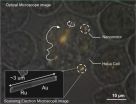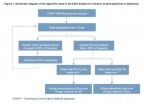(Press-News.org) For the first time, a team of chemists and engineers at Penn State University have placed tiny synthetic motors inside live human cells, propelled them with ultrasonic waves and steered them magnetically. It's not exactly "Fantastic Voyage," but it's close. The nanomotors, which are rocket-shaped metal particles, move around inside the cells, spinning and battering against the cell membrane.
"As these nanomotors move around and bump into structures inside the cells, the live cells show internal mechanical responses that no one has seen before," said Tom Mallouk, Evan Pugh Professor of Materials Chemistry and Physics at Penn State. "This research is a vivid demonstration that it may be possible to use synthetic nanomotors to study cell biology in new ways. We might be able to use nanomotors to treat cancer and other diseases by mechanically manipulating cells from the inside. Nanomotors could perform intracellular surgery and deliver drugs noninvasively to living tissues."
The researchers' findings will be published in Angewandte Chemie International Edition on 10 February 2014. In addition to Mallouk, co-authors include Penn State researchers Wei Wang, Sixing Li, Suzanne Ahmed, and Tony Jun Huang, as well as Lamar Mair of Weinberg Medical Physics in Maryland U.S.A.
Up until now, Mallouk said, nanomotors have been studied only "in vitro" in a laboratory apparatus, not in living human cells. Chemically powered nanomotors first were developed ten years ago at Penn State by a team that included chemist Ayusman Sen and physicist Vincent Crespi, in addition to Mallouk. "Our first-generation motors required toxic fuels and they would not move in biological fluid, so we couldn't study them in human cells," Mallouk said. "That limitation was a serious problem." When Mallouk and French physicist Mauricio Hoyos discovered that nanomotors could be powered by ultrasonic waves, the door was open to studying the motors in living systems.
For their experiments, the team uses HeLa cells, an immortal line of human cervical cancer cells that typically is used in research studies. These cells ingest the nanomotors, which then move around within the cell tissue, powered by ultrasonic waves. At low ultrasonic power, Mallouk explained, the nanomotors have little effect on the cells. But when the power is increased, the nanomotors spring into action, moving around and bumping into organelles -- structures within a cell that perform specific functions. The nanomotors can act as egg beaters to essentially homogenize the cell's contents, or they can act as battering rams to actually puncture the cell membrane.
While ultrasound pulses control whether the nanomotors spin around or whether they move forward, the researchers can control the motors even further by steering them, using magnetic forces. Mallouk and his colleagues also found that the nanomotors can move autonomously -- independently of one another -- an ability that is important for future applications. "Autonomous motion might help nanomotors selectively destroy the cells that engulf them," Mallouk said. "If you want these motors to seek out and destroy cancer cells, for example, it's better to have them move independently. You don't want a whole mass of them going in one direction."
The ability of nanomotors to affect living cells holds promise for medicine, Mallouk said. "One dream application of ours is Fantastic Voyage-style medicine, where nanomotors would cruise around inside the body, communicating with each other and performing various kinds of diagnoses and therapy. There are lots of applications for controlling particles on this small scale, and understanding how it works is what's driving us."
INFORMATION:
The research was funded by the National Science Foundation (MRSEC grant DMR-0820404), the National Institutes of Health, the Huck Innovative and Transformative Seed Fund (HITS) and Penn State University.
[ Krista Weidner ]
CONTACTS
Tom Mallouk: tom.mallouk@gmail.com, (+1) 814 863 9637
Barbara Kennedy (PIO): science@psu.edu, (+1) 814 863 4682
IMAGE
A high-resolution image is online at http://science.psu.edu/news-and-events/2014-news/Mallouk2-2014 , which is where this press release will be posted after the news embargo lifts.
IMAGE CAPTION and CREDIT: Optical microscope image of a HeLa cell containing several gold-ruthenium nanomotors. Arrows indicate the trajectories of the nanomotors, and the solid white line shows propulsion. Near the center of the image, a spindle of several nanomotors is spinning. Inset: Electron micrograph of a gold-ruthenium nanomotor. The scattering of sound waves from the two ends results in propulsion. (Photo credit: Mallouk lab, Penn State University)
Nanomotors are controlled, for the first time, inside living cells
2014-02-10
ELSE PRESS RELEASES FROM THIS DATE:
Matchmaking this Valentine's Day: How it can bring you the most happiness
2014-02-10
Austin – February 10, 2014 – With Valentine's Day around the corner, you may be thinking of pairing up two friends for a date. If you follow your instinct to play Cupid, it'll pay off in happiness – not necessarily for the new couple, but definitely for you.
According to new research, matchmaking, a time-honored tradition, brings intrinsic happiness to the matchmaker. To maximize the psychological benefits of matchmaking, you should take care to introduce two people who not only seem compatible but who would be unlikely to meet otherwise, researchers say.
"At some point, ...
Genetic discovery to keep crops disease-free
2014-02-10
Curtin University researchers have found a way to breed disease-resistant wheat with no downside, potentially bringing multi-million dollar savings to Australia's agricultural industry.
According to John Curtin Distinguished Professor Richard Oliver, Director of the Australian Centre for Necrotrophic Fungal Pathogens (ACNFP) at Curtin, farmers can lose more than 0.35 tonnes per hectare in wheat yields to Yellow Spot, even after applying fungicide.
For an average-sized farm of 4000 hectares, this could mean an almost $500,000 loss to disease per year – or about $212 ...
Slowing down the immune system when in overdrive
2014-02-10
Many people suffer from chronic inflammation because their immune systems overreact to 'self' tissue. Sydney scientists believe that a small molecule known as Interleukin 21 is a promising therapeutic target in such cases.
Interleukin 21 (IL-21) is one of a group of chemical messengers known as 'cytokines', which affect the behaviour of immune cells. IL-21 is already well known to play an important role in autoimmune diseases such as Sjögren's syndrome and type 1 diabetes.
The current study shows how much IL-21 contributes to inflammation. It also shows how important ...
When you always gotta go…
2014-02-10
Problems related to urination, including incontinence and having to get up to urinate at night-time, have become more acceptable topics of discussion over recent years. New treatment options have also led doctors to address these symptoms more actively. Despite this, no study has effectively compared the bother of each of these bladder symptoms for men and women of all ages.
The FINNO Study is an ongoing questionnaire survey conducted right across Finland. A random sample of 6,000 adults identified from the Finnish Population Register, were contacted with a questionnaire ...
New trial results affirm better blood pressure management during C-section
2014-02-10
10 February 2014, Singapore: New trial results1 have shown that the world's first Double
Intravenous Vasopressor Automated (DIVA) System affords superior control of maternal blood pressure in women undergoing caesarean section under spinal anaesthesia, when compared with manually-administered medication to manage reduced blood pressure (vasopressor).
Developed by doctors at KK Women's and Children's Hospital (KKH), the novel DIVA System detects and responds rapidly to low blood pressure and/or slow heart rate in real time by auto-administering a precise amount of the ...
Normal enzyme aids a mutant 1 to fuel blood cancer's growth
2014-02-10
BOSTON (Feb. 10, 2014)—Reinforcing the need to look beyond genomic alterations to understand the complexity of cancer, researchers from Dana-Farber/Boston Children's Cancer and Blood Disorders Center report that a normal enzyme called SYK pairs with FLT3, the most commonly mutated enzyme found in acute myelogenous leukemia (AML), to promote progression of the disease. This molecular partnership also promotes AML cells' resistance to treatment with FLT3-blocking drugs, potentially explaining the relatively poor showing of FLT3 inhibitors in multiple clinical studies. In ...
Flat-pack lens boosts solar power
2014-02-10
Micro-machining could be used to create almost flat, Fresnel lenses, that boost the electrical efficiency of solar panels, according to researchers in China.
Fresnel lenses were invented by French engineer and scientist Augustin-Jean Fresnel, in the early nineteenth century, they are essential two-dimensional equivalents of conventional optical lens, but they have ridges in concentric rings that focus the light to a point behind the lens without the three-dimensional bulk of a conventional lens. Image quality is reduced when using a Fresnel lens to focus because the concentric ...
Study reveals unexpected cell hijack method in pancreatic cancer
2014-02-10
Pancreatic stellate cells, which normally aid tissue repair, unwittingly help pancreatic cancer grow and spread in a method of 'cell hijack' only seen before in brain and breast cancer, according to new research from Queen Mary University of London.
The research, published in the latest issue of EMBO Molecular Medicine and carried out by Queen Mary's Barts Cancer Institute, also revealed the process can be blocked, thereby preventing the growth and spread of the tumour.
The study, funded by the UK charity Pancreatic Cancer Research Fund, set out to investigate the messaging ...
EORTC characterizes responders & survivors on pazopanib for advanced soft tissue sarcoma
2014-02-10
An EORTC analysis appearing in Annals of Oncology confirmed the importance of known prognostic factors such as performance status and tumor grading for having a long-term outcome in patients treated with pazopanib for metastatic soft tissue sarcoma. Additionally, hemoglobin at baseline was found to be a new prognostic factor.
Soft tissue sarcomas are a heterogeneous and relatively rare tumor with an estimated incidence of four per 100,000 people per year in Europe. The prognosis for patients with this disease is favorable if they are diagnosed at an early stage and if ...
Massive neutrinos solve a cosmological conundrum
2014-02-10
Scientists have solved a major problem with the current standard model of cosmology identified by combining results from the Planck spacecraft and measurements of gravitational lensing in order to deduce the mass of ghostly sub-atomic particles called neutrinos.
The team, from the universities of Manchester and Nottingham, used observations of the Big Bang and the curvature of space-time to accurately measure the mass of these elementary particles for the first time.
The recent Planck spacecraft observations of the Cosmic Microwave Background (CMB) – the fading glow ...


